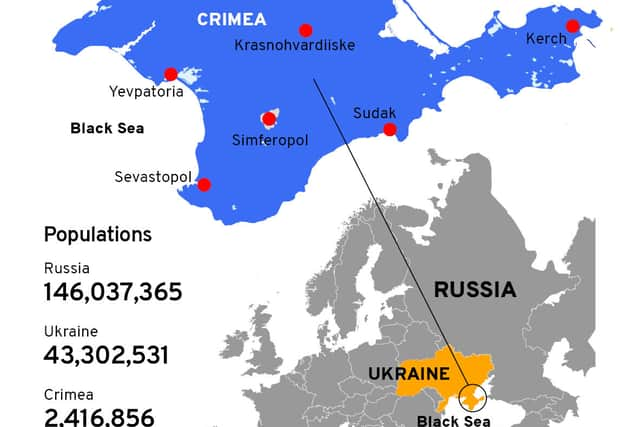Where is Crimea? Bridge to Russia attack explosion explained, Ukraine map, who owns it - is it part of Russia?
and live on Freeview channel 276
On Saturday (8 October), an explosion on a bridge connecting the Crimean Peninsula to Russia caused its partial collapse, damaging a major supply artery for the Kremlin's faltering military effort in southern Ukraine.
Nobody has yet claimed responsibility for the explosion, which killed three people. The speaker of Crimea's Russian-backed regional parliament accused Ukraine, and Russian President Vladimir Putin described the attack as “a terrorist act” orchestrated by Ukrainian special forces.
Advertisement
Hide AdAdvertisement
Hide AdUkrainian officials have often threatened to strike the bridge, a symbol of Russian dominance in the region, and some have praised the collapse, but Kyiv has not claimed responsibility.
Crimea has changed hands many times over its beleaguered history, and its past is complicated and disputed.
Indeed, the issue of the peninsula and its rightful claimants is a debate so long-reaching that it is often politically referred to simply as “the Crimea Problem.”
It’s just one of the myriad complex geopolitical issues that has led us to the ongoing Ukraine/Russia conflict.
Here is everything you need to know about it.
Where is Crimea?


Advertisement
Hide AdAdvertisement
Hide AdCrimea is a peninsula in the south of Ukraine that juts out into the Black Sea.
An estimated 2.4 million people live there, including Ukrainians, Russians, Crimean Tatars, the indigenous people of Ukraine on the territory of the Crimean peninsula officially recognised by the Ukrainian government earlier this year.
What is its history?
Late in the 18th century, the Russian Empire won a war against the Ottoman Empire and took control of the peninsulaa.
Just under 100 years later, from 1853 to 1856, the peninsula was the site of the Crimean War, a conflict fought between the Russian Empire and an alliance of France, Britain, the Ottoman Empire, and Sardinia.
Advertisement
Hide AdAdvertisement
Hide Ad60 years later, following the Russian Revolution of 1917, Crimea changed hands numerous times during the Russian Civil War.
The peninsula became part of the Russian Soviet Federative Socialist Republic in 1921 as the Crimean Autonomous Soviet Socialist Republic, which became part of the Soviet Union in 1922.
It was part of Russia until the Soviet Union gave it to Ukraine in 1954. It became the Autonomous Republic of Crimea, part of Ukraine, but with a limited ability to impose its own devolved rules.
The seat of the government is Simferopol, which is also Crimea’s biggest city.
When did Russia annex Crimea?
Advertisement
Hide AdAdvertisement
Hide AdIn March 2014, a series of protests known as the Revolution of Dignity culminated in the ousting of elected president Viktor Yanukovych and the overthrow of the Ukrainian government.
Russia saw this move as a sign that Ukraine could more closely align itself with the West in future, and in response, Russian troops took control of Crimea.
Russia then held a referendum in Crimea, in which voters were asked whether the disputed territory should officially become a part of the country of Russia.
Despite 95% of citizens voting in favour of joining Russia and the Crimean Parliament quickly declaring independence from Ukraine, the referendum is not legally recognised by the international community.
Advertisement
Hide AdAdvertisement
Hide AdUkraine and the world community consider Crimea to still be a Ukrainian territory under law.
The conflict has been ongoing ever since, and the UN estimates at least 14,200 people to have been killed in eastern Ukraine, including over 3,000 civilians.
Russia was expelled from the G8 group of leaders (hence it now being known as the G7) as a result of its capture of Crimea, and the United Nations passed a resolution declaring the resolution invalid and the peninsula to still be a part of Ukraine.
What happened on the Kerch bridge?
The blast on the Kerch bridge, which Russian authorities blamed on a truck bomb, raised the prospect of a swift escalation in Russia's eight-month war.
Advertisement
Hide AdAdvertisement
Hide AdOn Sunday (9 October), President Putin described the attack on the large bridge connecting Russia to its occupied area of Crimea as “a terrorist act" orchestrated by Ukrainian special forces.
Russia’s investigative committee has initiated a criminal terror probe into the explosion. The bridge's road and train traffic were briefly suspended, disrupting a crucial supply line for the Kremlin's military and dealing a severe damage to Russian reputation.
Comment Guidelines
National World encourages reader discussion on our stories. User feedback, insights and back-and-forth exchanges add a rich layer of context to reporting. Please review our Community Guidelines before commenting.
